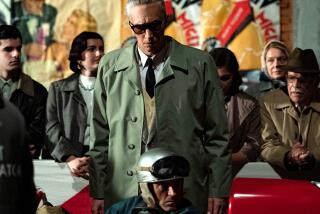Image Is Everything in ‘Mandala’
- Share via
Nearly naked and bathed in golden light, Daniel Ezralow stands on the stage of the Freud Playhouse at UCLA striking sculptural poses in front of a projection screen that shows a moving panorama of the antique Arena di Verona in Italy. Lush, shimmering music by Michel Colombier and slides of ancient statues that appear on additional wall screens help the 41-year-old dancer-choreographer create a classic statement of butch pulchritude: Ecce Homo--Behold the Man.
And not just any man: Behold the Media Narcissus, with Ezralow using up to six slide and video screens to indulge his self-infatuation, where the original Narcissus had only his reflection in a pool. Controlled by Ezralow in the roles of director, videographer and co-editor, the environmental video projections on the three screens behind him always remain symmetrical, framing him in the center and making the world revolve around him. And when the world isn’t enough, he clones himself photographically and sends all of him into outer space.
This is “Mandala,” Ezralow’s 2-year-old multimedia spectacle in its American premiere on Friday, a 55-minute work that manages to fuse our society’s current obsessions with the male anatomy and special effects while never deviating from its mission of conveying the power and glory of being Daniel Ezralow. Indeed, it’s such a perfect distillation of what some people consider the Southern California zeitgeist of the ‘90s that it deserves to be on permanent display somewhere--ideally on the Sunset Strip, next to the Bullwinkle statue.
In format it retools the premise that inspired the 1924 Buster Keaton film comedy “Sherlock, Jr.” and has been mostly misused ever since: trapping a living person inside a movie and watching how the abrupt shifts from one film location to another give that person impossible physical challenges.
Thus we see the live Ezralow interacting with the video backgrounds and seeming to run frantically along Italian railroad tracks, dodge commuters in Finland and even soar above the clouds. As artfully lighted by Howell Binkley and realized by a battalion of technical wizards, the stagecraft proves unfailingly entertaining and sometimes leads Ezralow to momentarily lighten up: in an almost delicate aerial solo, for instance, or in a sequence set in a library that makes the search for knowledge a sensual experience. Even in a couple of the bounding passages that represent the work’s closest links to conventional choreography.
Unfortunately, as the image manipulation heats up, the dancing diminishes proportionately and at its most minimal leaves no trace of the Ezralow who gave memorable performances with the Lar Lubovitch, Paul Taylor, Pilobolus, Momix and ISO companies. In his place, we have an overload of beefcake hubris, with Mietta Corli’s elegantly deployed multiple projection screens used like multiple mirrors in a boutique: to show every angle of the hunk on view.
Those angles include Ezralow the Sacred (in which he wanders cloistered halls to what sounds like medieval church music), Ezralow the Profane (in which he explores the landscape formed by a giant reclining naked woman), plus, ultimately, the cosmic, jet-propelled Ezralow the Explorer, zooming ever onward toward his destiny among the stars. And, alas, in imminent danger of becoming the Michael Flatley of modern dance.
No further performances are scheduled, but you can catch samples of Ezralow’s dancing and choreography on the Academy Awards telecast tonight.
More to Read
The biggest entertainment stories
Get our big stories about Hollywood, film, television, music, arts, culture and more right in your inbox as soon as they publish.
You may occasionally receive promotional content from the Los Angeles Times.










